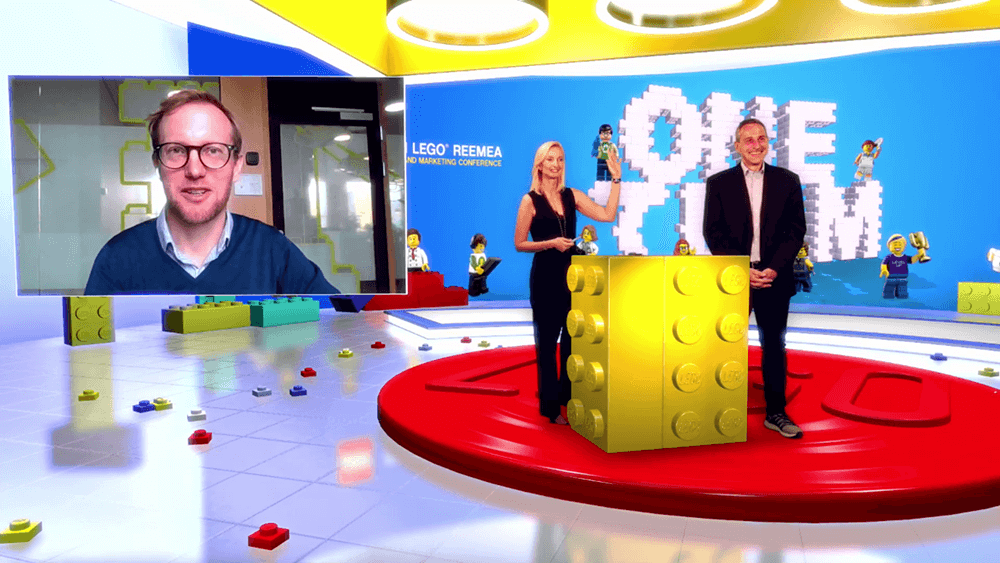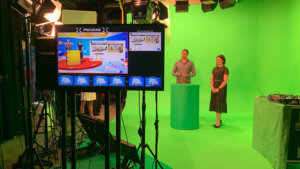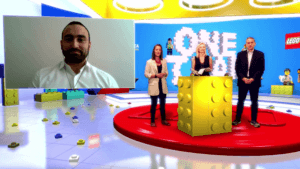
Andrea Faflíková, director of PR, communications and events/REEMEA for the LEGO Group, stands in a custom-made 3D virtual studio during a LEGO digital event.
In April, Andrea Faflíková found herself in a position all-too familiar to many event organizers in the wake of the pandemic: She had to move a face-to-face event online in a matter of weeks. But unlike many other organizers, Faflíková — the Prague, Czech Republic–based director of PR, communications and events/REEMEA for the LEGO Group — didn’t scramble to find a platform for the 200-plus-person event.
To follow corporate policy, the event needed to be delivered via Microsoft Teams — an internally approved tool for the LEGO Group. Hosting the event on Teams would ensure the confidential content shared during the three-day event — in which the sales and marketing team from 13 different locations, including in Europe, Russia, Dubia, and South Africa, would participate — would be secure.

Using green screen technology, XLAB Realtime developed a customized 3D virtual studio for the LEGO virtual event.
But Faflíková was determined not to let one platform limit her creativity, so she partnered with XLAB Realtime to develop a customized 3D virtual studio that was integrated with the Teams platform. Speakers from around the globe seamlessly presented over XLAB’s Virtual Event tool — even appearing as if they were simultaneously speaking next to each other in the studio — to create a highly immersive environment for the participants. And with its green screen technology, customized graphics and animation were easily accommodated, Faflíková said.
The program featured a smooth mix of different formats, including PowerPoint, livestreaming, and videos, she added, with Sli.do tacked on to enable interaction among participants. More than 300 questions were sent by participants, and polls and surveys were sprinkled throughout during the program, which also featured a moderator and a DJ.
Faflíková provided a list of “10 Commandments” to speakers in advance, she said, the first of which was that they weren’t to say that the virtual event was a lesser substitute for the live one. “We said, ‘There’s no way you’re going to start out by saying, “It’s a pity that we cannot meet together [in person] and that we can’t be in the same room.”’ I’m like, if anybody says that, I will kill them,” she added with a laugh. “Because then it’s devaluation of the event, right? So you say it once, somebody says it a second time, and by the third time, everybody thinks it’s true.”
One other rule for speakers was that their presentations shouldn’t last longer than “15, 20 minutes, max,” she said. After each session, Faflíková moderated a Q&A session.

Speakers from around the globe seamlessly presented at the LEGO virtual event using XLAB’s Virtual Event tool — even appearing as if they were simultaneously speaking next to each other in the studio.
The program cadence also took into consideration the different geographies, time zones, and cultures of the participants, incorporating more frequent and longer breaks “because of the fact that Central Europeans eat at a different time than people in the Middle East,” she said.
Some of the content was pre-recorded but not shared in advance with the participants. “We did not distribute the content,” Faflíková said, “honestly because we wanted everybody to listen when they should listen, and when they had also possibility to ask questions.”
After “many, many rehearsals,” she said, the virtual event went off without a hitch and was extremely well-received. “Actually, we got the same marks as last year” at the face-to-face event, Faflíková said, and “last year people were saying that it was the best conference ever. Of course, I have to add that people expected that they were going to end up in a regular Teams meeting,” so they were pleasantly surprised with the virtual studio approach.
Even so, a familiar refrain in participants’ feedback went something like this, she said: “’We loved your solution. It’s great. It’s more than enough.’ But then they’re like, ‘Next year, [the in-person] event won’t be canceled, right?’”
Michelle Russell is editor in chief of Convene.
